Content
- 1 Plant characteristic
- 2 How to grow at home on a windowsill
- 3 Indoor hot pepper care
- 4 Diseases and pests
- 5 Varieties and features of the plant
- 6 Properties of bitter pepper
- 7 Secrets of growing hot pepper
- 8 Picking and planting peppers in a permanent place
- 9 Hot pepper transplant rules
- 10 Features of growing on a windowsill
- 11 Choosing a variety for planting
- 12 Features and conditions for planting at home - step by step instructions
- 13 Features of further care
- 14 Major diseases and pests
- 15 The timing of emergence and the first harvest
Bitter pepper on the windowsill is not only a necessary spice, which is always at hand, but also an excellent decorative home decoration, easy to grow. A pot with a bright beautiful plant will serve as an exquisite decor for any home, and the piquant taste of such a spicy spice will make this pepper indispensable in the kitchen of every hostess.
It is also possible to grow sweet bell peppers and hot hot peppers, Drakosha or other varieties at home. How to plant seeds for seedlings and about the conditions for planting in an apartment, we will tell further.
Plant characteristic
For growing on the windowsill, breeders specially bred several varietal varieties of hot peppers. Such indoor peppers are also divided into a fruit variety and an ornamental (no fruit) variety.
The fruit variety of indoor hot pepper is a perennial that reaches a height no more than 40 cm... The plant has bright green leaves and multi-colored fruits of a rich color: scarlet, sunny or orange.
Growing indoor pepper is not difficult and does not require special knowledge and wisdom. Very unpretentious and undemanding in care.
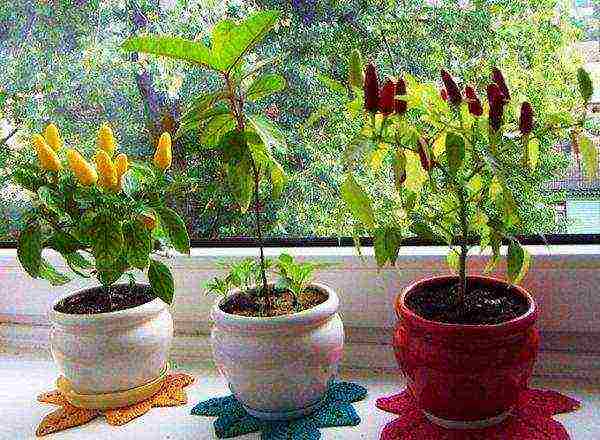 The windowsill is ideal for growing light-loving peppers
The windowsill is ideal for growing light-loving peppers
It is recommended to grow and plant peppers exclusively on windowsills, since the vegetable is very sun-loving, and with sufficient sunlight it will certainly delight you with beautiful fruits with a piquant pungent taste.
Flowering begins in June. During this period, delicate white flowers with a slightly yellowish tint appear on the stems.
How to grow at home on a windowsill
To get a plant with beautiful fruits on the windowsill, you need to sow seeds for seedlings. Do it late February - early March.
To speed up the process of seed growth, they can be pre-heat treated. For this, the seeds are poured with warm water (not higher than 40 degrees) and corked in a thermos for 3 hours.
Preparing the soil and pot
The soil for seeds must be chosen nutritious. You can prepare it yourself. To do this, mix 5 parts of humus, 2 parts of turf and peat and 1 part of sand. At the bottom of the container it is necessary there must be drainage... Small expanded clay or pebbles are suitable for this.
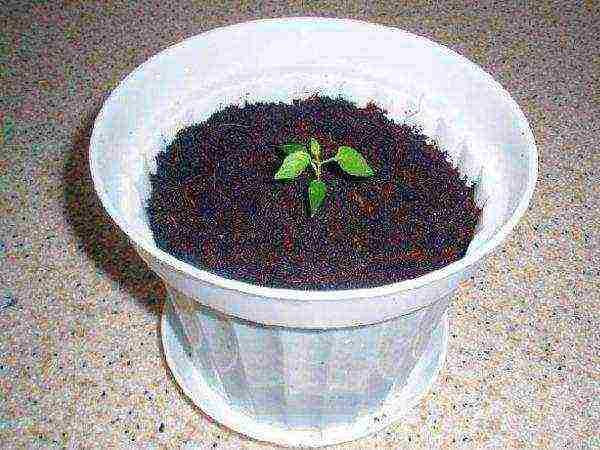 Peppers need nutritious soil
Peppers need nutritious soil
The soil must be additionally disinfected: treated with boiling water, or a solution of potassium permanganate and loosened well. Seeds are sown to a depth of 1 cm.
Growing seedlings from seeds
The containers are covered with glass or foil and left in a warm place where the temperature should not be below 20-25 degrees.
As a container, you can use a regular pot or box, it all depends on how many seeds are sown.
The first shoots appear already in 7 - 10 days... There should be enough sunlight in the room.
When the first shoots appear, the plants dive into separate pots. When several true leaves appear on the seedlings, they are dived again, while the strongest and strongest shoots are chosen.
 Pepper seedlings must be dived after the first shoots appear
Pepper seedlings must be dived after the first shoots appear
The plant needs a sufficient amount of moisture, heat and light, at any stage of growing.
During the growth of seedlings, it is necessary to ensure that the seedlings do not stretch too much. To do this, they need to provide a certain ambient temperature.
When the first leaves appear, then within 7 days it is necessary to reduce the temperature to 20 degrees. And when three real leaves appear, be sure to reproduce the pick in a spacious pot. Seedlings are planted in a permanent place after 2 months after planting seeds.
Indoor hot pepper care
To grow hot peppers on a windowsill, you need to provide him light and warm.
Fertilizer
He loves such a pepper of various kinds of feeding. The most optimal fertilizer is 2 tablespoons of ash mixed with 3 liters of water. The mixture should brew well. Fertilize is necessary every two weeks.
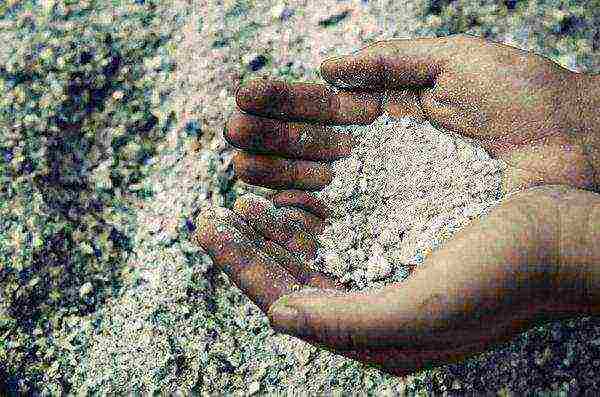 Wood ash diluted in water is suitable for feeding peppers.
Wood ash diluted in water is suitable for feeding peppers.
Nitrogen fertilizers can be used, but much less frequently. With such fertilizers, it is important not to overdo it, otherwise you may be left without a crop.
Watering
The soil must be regularly loosened and watered two times a week warm, settled, or purified water. It is necessary to ensure that the soil in the pot does not dry out, but it is also not constantly damp. Both will contribute to various plant diseases.
In winter, you can not use fertilizers and water the plant much less often. If the air in the room is dry, you can slightly moisten the leaves by spraying them with water from a spray bottle.
In the warm season, the pots are taken out on the balcony or outside.
Fruiting
Subject to all the recommendations and rules of cultivation, the plant will bloom in May - June, and fruiting will continue until the end of the autumn period.
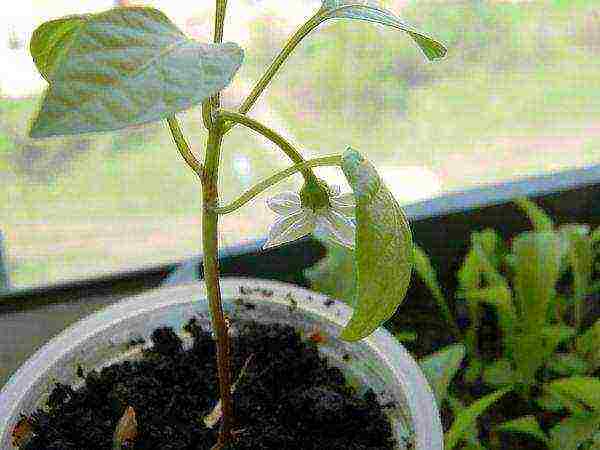 If the recommendations are followed, the pepper will bloom in early May.
If the recommendations are followed, the pepper will bloom in early May.
Temperature regime
Until about February, the plant can be kept indoors at a cooler temperature, but not lower than 18 degrees.
But before the start of the growing season (it usually starts in February), the pot must be moved to a warmer room and pruned. To do this, you need to cut the stems so that they are no higher than 5 cm.
If you correctly follow all the recommendations for growing and caring for the plant: starting from the harvesting of seeds itself and ending with timely cutting, then such a pepper will retain its decorative effect and will actively bear fruit up to 5 years.
Diseases and pests
This type of indoor plants can be subject to the following diseases: blackening of the stem or spotting of the leaves... This happens with too much watering, in which stagnation of water in the pot is formed.
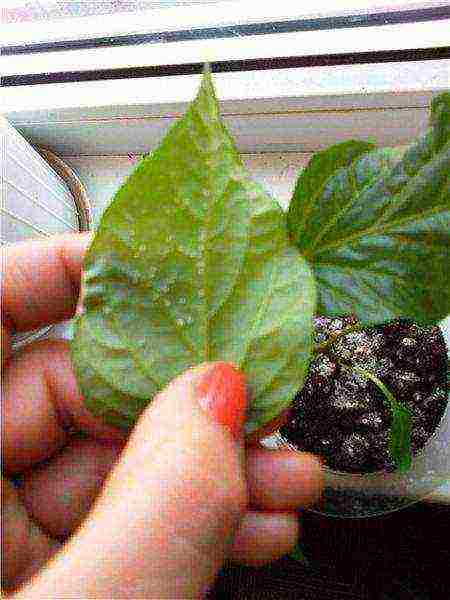 Powdery mildew on indoor peppers
Powdery mildew on indoor peppers
The main pests of this pepper include aphids, spider mites and powdery mildew... Aphids or mites can appear with the help of the wind through an open window.
You can use the plant itself to fight the tick. To do this, it is necessary to grind the pepper seeds along with the inner veins and pour water over them for a day.Then you need to add a little grated laundry soap to the mixture and spray the plant. To completely get rid of pests, it is enough to carry out three spraying procedures.
In order to prevent the appearance of a tick, you need to provide the plant with sufficient moisture or put a container of water near the pot of pepper.
With proper cultivation and care, the plant will delight the eye with excellent decorativeness for as long as 5 years, and its fruits will become a piquant spice in the kitchen.
Bitter pepper is not only a useful spice, which is difficult to do without when preparing meat dishes, but also a bright, beautiful plant that can give joy and admiration. How to grow healthy plants and get an amazing bush with colorful peppers at home? This is not difficult if you know how to choose a variety and properly care for young seedlings.
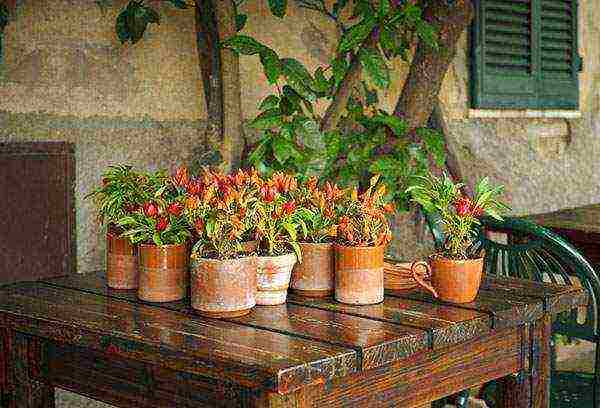
Varieties and features of the plant
The bushes of hot peppers of the varieties Adjika, Ogonyok, Chili reach a height of 50 cm. On one plant, multi-colored fruits can grow: white, green, orange, purple, yellow. Indoor hot chili is a long-liver. The bush can bear fruit for 5-6 years.
It is interesting
In Europe, pots of decorative peppers for Christmas are put on the balcony, windowsill, near the house.
In shape, the pods on the bush are round, flattened, similar to a pyramid or cylinder. Chili has long, pointed fruits, and Ogonyok will delight you with cone-shaped, bright peppers. On one plant, about fifty fruits can ripen at the same time.

Properties of bitter pepper
Both garden red peppers and decorative chili peppers, Ogonyok, Adjika, Indian Summer are used in cooking for preserving and preparing delicious dishes. For those who are engaged in the cultivation of such plants, a balcony or windowsill is also a spice shop.
- The fruits have antibacterial properties and protect the premises from the harmful effects of microbes.
- Vases with a plant are placed on the balcony near indoor flowers, which are affected by aphids and mites. Pests disappear in a few days. Chili peppers do this well.
- Food with the addition of a small amount of pepper improves appetite and boosts immunity.
You can buy a hot pepper bush in a store or market. In the spring, flower markets sell young seedlings of the varieties Ogonyok, Coral, For the mother-in-law. But it is best to grow hot hot peppers at home from seeds and decorate the balcony and windowsill with elegant bushes.
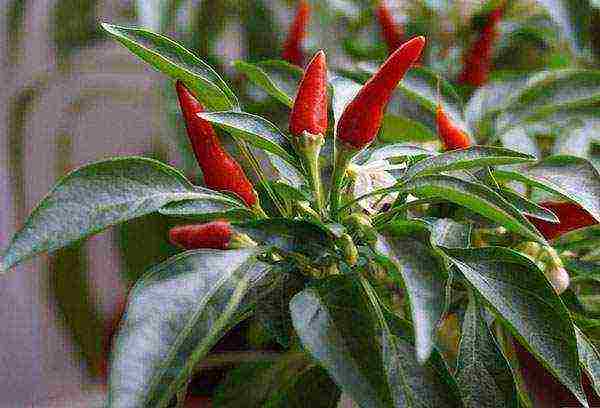
Secrets of growing hot pepper
Have you decided to grow hot peppers on the windowsill? First you need to choose the type of pepper: indoor or hot red, which grows in gardens. Some varieties of open ground have shown themselves well in indoor conditions: Chile, Adjika, Coral. They grow well indoors and delight with a rich harvest.
All types of ornamental peppers are designed for indoor cultivation. A balcony is also suitable for successful content. Plants with multi-colored pods look beautiful on the window. Cultivation of bitter pepper Ogonyok, Indian Summer, Bolivia, Dark Olive, Mambo, Medusa will create a bright parade of colors on the balcony.
If you know the secrets of caring for this plant, then it is easy to get beautiful bushes that will delight the eye and give a rich harvest.
- The key to a rich harvest is seeds. Their quality determines the strength of growth and the capabilities of the plant. Seeds that have been stored for a long time will not grow a strong plant. An important point before sowing is seed calibration. To do this, take a glass of warm water, add a tablespoon of salt to it. The water is stirred and waited for a few minutes. After pre-drying, sow that part of the seeds that sank to the bottom of the glass.
Important!
Sowing seeds should be calculated so that the first shoots appear in March. During this period, the daylight hours are already long and the plants have enough sunlight for normal development.
- An important point is soil preparation. Hot peppers are undemanding to the soil and grows well on ordinary garden land, but it is better to create comfortable conditions for the plant. Indeed, in the garden soil there can be pests or an infection that will lead to the loss of seeds even before the emergence of shoots. For sowing, purchased peat or a mixture based on it is suitable.
- Moisten the soil before sowing. It should crumble in your hand and be damp. Peppers are sown in small containers with holes at the bottom. A bowl or seed pot is suitable for this. Seeds are laid out in a checkerboard pattern and covered with a low layer of earth (up to 2 cm). The earth is compacted, the dish is covered with film or glass.
- For quick emergence of shoots, they maintain a high temperature (up to 25 degrees), constant humidity and ventilate. Until the sprouts appear, the soil is not watered, but only sprayed from the sprayer.
- When the first shoots appear, the container is opened and placed in a greenhouse or simply put on the balcony. At this time, it is necessary to ensure that a black leg does not appear: you need to limit watering and not lower the temperature below 22 degrees.
Advice
On some seedlings, a film of seeds may remain, which sticks together the cotyledons. It is not always possible to remove it so as not to harm the plant. Try to moisten the skin with water and, after a few minutes, gently pull it off the leaves.
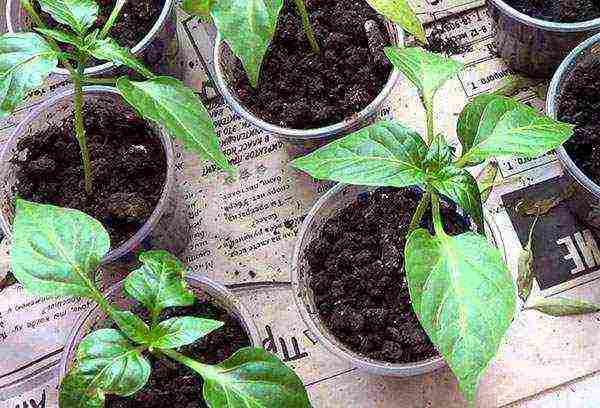
Picking and planting peppers in a permanent place
They start picking seedlings at home when the third true leaf appears on the plant. The soil is watered so that the entire earthen mixture is saturated, a day before the procedure. Dive seedlings into moist, but not wet soil. It is better to replant the plants so as not to injure the roots. This can be done with a garden trowel or a regular spoon. After transplanting, the cups are placed in a greenhouse on the windowsill so that the seedlings quickly take root. A new leaf after a pick is a signal that the pepper has successfully rooted and you can start feeding.
At the first stage, the peppers need nitrogen and potassium supplements for the development of the vegetative system. But do not get carried away: an overdose can destroy the plant.
Advice
Top dressing is carried out one day after watering, with wet soil. Plants with signs of the disease should not be fed. First you need to find out the reason for the poor condition of the bush, eliminate errors in cultivation - and only after that add minerals.
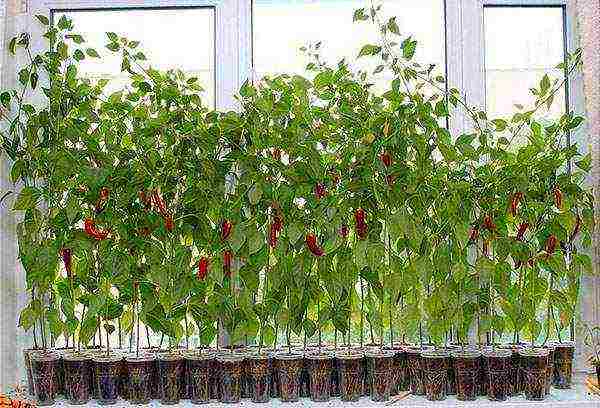
Hot pepper transplant rules
As soon as the roots of the pepper wrap the soil in the cup, they begin to plant in a permanent place. How to do it right?
- For the first planting, take a pot with a capacity of no more than one liter, put drainage on the bottom (expanded clay, bark, pebbles) and pour an earthen pillow. Planting mix is purchased at the store.
- The plant is buried so that the root collar is lowered into the ground by no more than 2 centimeters. Over time, the soil will sink, and the root collar will be at ground level. With a strong deepening, the plant may die or late enter the fruiting phase.
- Top dressing begins two weeks after transshipment. When grown at home, chili peppers respond very well to feeding with phosphorus and potassium fertilizers, calcium, and magnesium. In order not to get confused with dosages, it is better to buy ready-made fertilizers for indoor peppers. If chili peppers are grown for culinary purposes, it is best to use organic fertilizers.
- At home, for successful fruit setting, it is necessary to shake the bushes during flowering so that pollination occurs.
Advice
Indoor pepper Spark does not tolerate drying out of the soil. It reacts especially sharply to a lack of water during flowering. If the soil in the pot is dry, then the plant can shed its buds or ugly fruits will tie.
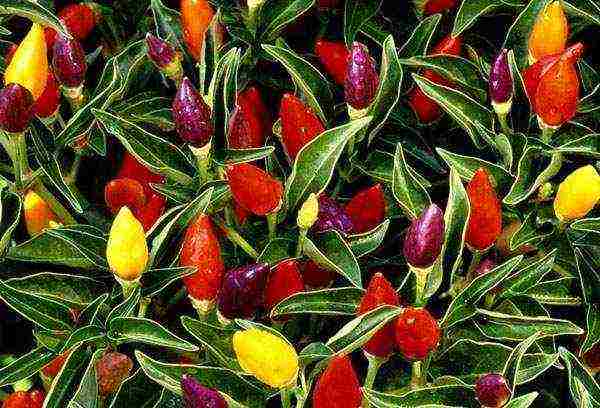
Drafts and dry air are detrimental to the Chili and Ogonyok peppers when grown at home. Then the plants shed their leaves and hibernate.If this happens, do not be alarmed. You just need to create comfortable conditions on the balcony or windowsill. Then the growth of Chile and Ogonyok will quickly resume.
So, a small step-by-step instruction on breeding hot peppers on the balcony will help even beginners cope with this task. Growing pepper on a windowsill does not require special attention, it is only important to remember that during the sun period it is necessary to shade the plant and water it with warm, settled water. We must not forget about the annual transfer to a larger pot - this will allow the bush to build up a healthy root system.
In the cold season, you want to create a special comfort in the house, and plants grown on the windowsill at home are ideal for this. Indoor pepper is no exception, it will not only add originality to the interior, but also give spicy food lovers an opportunity to spice up their dishes.
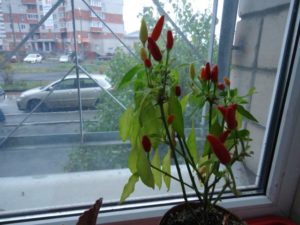
Features of growing on a windowsill
Important! With proper care and regular feeding, indoor peppers can grow fully and give a stable harvest for 5 years.
Growing pepper on a windowsill is not only an exciting experience, but also useful... Eating pepper in food, even in minimal quantities, can normalize metabolism in the body, reduce cholesterol and blood sugar levels.
For the successful cultivation of pepper on the windowsill, you need to create optimal conditions for its growth and development, because this culture is a little capricious. Therefore, it is necessary to familiarize yourself in advance with the features and preferences of the plant, as well as with the rules of planting and further care.
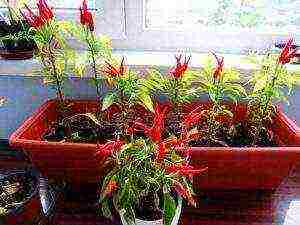
To grow peppers at home, you need to consider the following factors:
- seeds of a suitable variety from a trusted manufacturer or freshly cut cuttings;
- choosing the optimal place for plant growth;
- selection of planting containers and a suitable substrate;
- lighting and feeding features;
- knowledge of diseases and pests of pepper.
Important! With the observance of all the rules of care from one plant, you can get one hundred or more fruits at the same time.
Choosing a variety for planting
Before planting pepper, you need to decide on its variety. Having picked up several different types of plants, you can create a multi-colored vegetable garden on the windowsill, which will delight with its bright fruits.
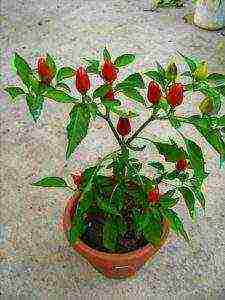
The following varieties of decorative peppers are ideal for growing on a windowsill in an apartment:
- A twinkle. This variety has long been popular for its compact shrub, which grows to a height of 40 cm. It was bred by crossing chili and cayenne pepper. Forms fruits up to 5 cm, which at the base have a diameter of 1-1.2 cm. As they grow, they change their color: green, yellow, red. The fruits ripen within 120 days.
- Aladdin. Ultra-early compact variety, the height of the bush reaches 35-40 cm at home. Forms cone-shaped multi-colored fruits, the length of which does not exceed 3 cm. In the process of growth, the shade of the fruit changes: green, purple, red. Fruit ripening occurs within 105 days.
- Garda Firewoks. One of the new indoor varieties. Forms compact bushes with a height of 30 cm. The length of the pods is 5 cm. The peculiarity of the pepper is that the fruits stick out with their tips up. As they ripen, they change their color, so the plant can simultaneously have fruits of green, lilac, orange and red. Pods ripen within 115 days.
- Exploding amber. The peculiarity of the variety is that the foliage of the plant has a dark purple color. Forms cone-shaped small fruits 2.5 cm long. As they grow, the shade of the fruits also changes: purple, pink, scarlet. The bush is compact, 30 cm high. The variety is considered early ripening, the fruits ripen in 115 days.
Depending on individual preferences, you can pick up one or more varieties at the same time.
As a rule, the most popular variety for growing on a windowsill is Spark pepper.
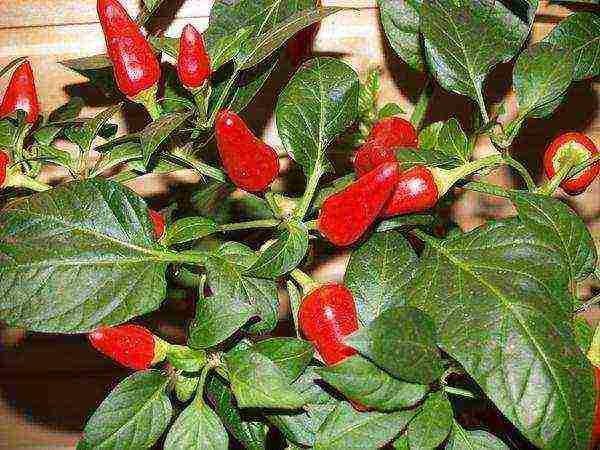
Important! You cannot use seeds from a store-bought pod to grow pepper on a windowsill, since it is an industrial variety and needs completely different conditions.
Features and conditions for planting at home - step by step instructions
To grow Spark pepper on the windowsill, you need to prepare for the procedure by studying the preferences and features of growing this culture in room conditions. Only by observing all the stages of planting, you can achieve the desired result in the end.
Choosing a suitable location and creating optimal conditions
Hot peppers are very picky about light and heat, for its full growth and development it is necessary to choose south or east window sill. During the period of active sun in spring, the plant needs light shading. In summer, the plant should be taken out to the balcony or loggia, but drafts must be excluded.
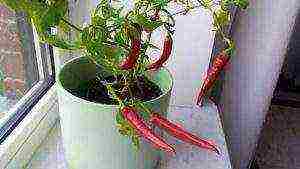
For full growth and development, the plant needs 12-hour daylight hours. In the period of short days from the beginning of October to the end of January, bitter pepper especially needs additional lighting with phytolamps in the evening and cloudy days.
Important! Lack of light is manifested by a light shade of foliage, which can eventually lead to leaf fall, in this case the duration of additional lighting must be increased.
For normal plant growth in winter air temperature should not exceed 18 degrees C, and starting from spring, the optimal temperature is 20-22 degrees C.
Hot peppers are very picky about soil moisture and does not tolerate watering with cold water. It is necessary to water the plant sparingly, with water at room temperature, as the top layer in the pot dries, but allowing it to absorb moisture from the pan. If water remains in the pan 1 hour after watering, then it must be completely poured out.
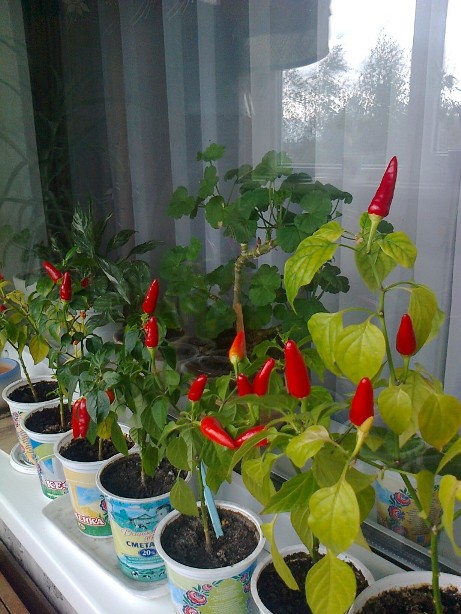
In conditions of low air humidity it is necessary to carry out additional spraying of foliage using a spray bottle.
Important! Pepper does not tolerate cold gusts of wind, therefore, when ventilating the room, it must be kept away from the open window.
Planting capacity
Indoor pepper forms a compact root system that is closer to the soil surface. For planting, it is recommended to select wide and shallow containers... The height of the planting pot should be within 10 cm.
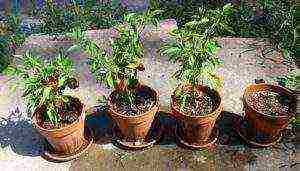
A prerequisite is the presence of drainage holes in the bottom of the pot, which helps to remove excess moisture. Before planting on the bottom, it is necessary to fill the drainage with a layer of 2 cm, which will exclude stagnation of water in the pot.
Suitable substrate
For planting hot pepper seeds, you can purchase Seedling substrate in a specialist store. But you can prepare a nutrient mixture for planting yourself. This will require the following components:
- 2 pieces of leafy land;
- 1 part peat;
- 1 part river sand;
- 1 part coconut fiber
- 1 part perlite or vermiculite.
Immediately before planting hot pepper seeds, it is necessary to disinfect the soil by spilling it with the fungicide Previcur, which will prevent the development of fungal diseases.
Presowing seed preparation
For the friendly emergence of seed germination and disease resistance of young plants, it is recommended to carry out pre-sowing treatment of planting material. To do this, you can use the following drugs:
- Epin - dilute 3 drops of the product in 100 ml of water, soak the seeds for 2-4 hours before planting;
- succinic acid - make a working solution at the rate of 1.5 g of the product per 1.5 l of water, soak the seeds for 12-24 hours;
- Zircon - for the solution, add 3 drops of the product to 100 ml of water, soak the seeds for 2-4 hours before planting.
After processing it is necessary to dry the planting material to a loose state.
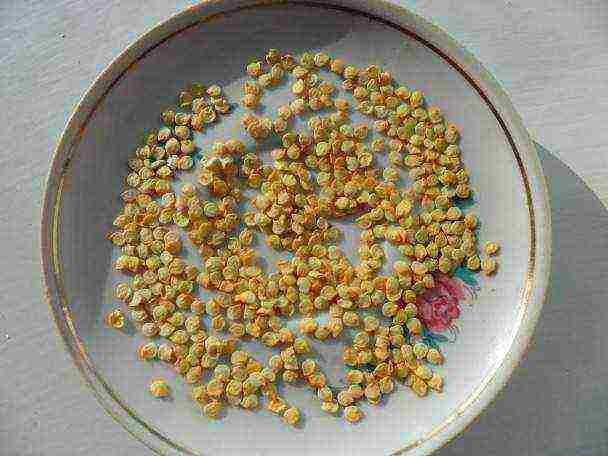
It is recommended to germinate pepper seeds in a humid environment before planting. To do this, you need to spread them in damp gauze and gently wrap the fabric.
For germination, place in a dark, warm place (25 degrees) for several days, periodically opening, moisturizing and examining for the presence of sprouts. Once most of the seeds have hatched, they must be planted in prepared soil.
Important! Seeds must not be allowed to dry out during the germination period, otherwise they will die.
In some cases, to preserve all view properties it is recommended to carry out cuttings of pepper. Cuttings must be cut from green young shoots without fruit, 7-8 cm long, and each of them should have 3-4 leaves.
Before planting them in the ground, it is necessary to soak in advance in a solution of zircon (3 drops per 100 ml of water) for 12-24 hours or powder the lower cut with root powder.
Step-by-step instructions for landing
To grow pepper on a windowsill, you must initially plant it correctly. Only if all the necessary conditions of the procedure are met, you can achieve the desired result in the end.
Step 1. Spill the planting containers with a strong solution of potassium permanganate.
Step 2. Fill the pots with the required substrate and level the surface.
Step 3. Moisten the soil abundantly with water and allow it to fully absorb.
Step 4. Place seeds on the surface and sprinkle with a layer of substrate 0.5 cm.
Step 5. Moisten the top layer with a spray bottle.
Step 6. Cover containers with glass or foil to maintain high humidity inside the landing container.
Step 7. Place the containers in a dark, warm place (25 degrees) until shoots appear.
When planting cuttings pepper, the procedure takes place in the same order, only they must be planted to a depth of 1-1.5 cm. And after planting and covering with a film, the pot is placed on the window, shading it from direct sunlight.
Video: how to grow pepper on a windowsill from cuttings
Features of further care
After the appearance of pepper sprouts, the container with seeds must be rearranged on the windowsill and the temperature must be lowered to 18-20 degrees. To exclude warm air from heating devices, they must be covered with a layer of foam.
Daily container with seedlings it is recommended to ventilate and take away from the cover or film gathered condensate using a paper napkin.

10-14 days after the emergence of sprouts, it is necessary adapt seedlings to the external environment... To do this, on the first day, it is recommended to open the container for 30 minutes, increasing this period by 30-40 minutes with each subsequent day. After a week, the glass or film must be removed completely.
Pepper cuttings take root within 2-3 weeks. When young leaves appear on them, it is necessary to begin the adaptation of plants to the environment. It is carried out in the same way as for seedlings obtained from seeds.
When 2-3 true sheets appear it is necessary to plant the peppers in separate containers. During transplantation, it is not recommended to pinch the main root, since the plant painfully tolerates this procedure and significantly slows down growth. The first planting should be carried out in pots with a diameter of no more than 9-10 cm.
Video: how to plant indoor peppers
Further it is necessary to transplant young seedlings as they grow. As soon as the roots start crowding in the pot, it is recommended to transfer the plant, increasing the diameter of the pot by 2-3 cm. The container for an adult plant should be 30 cm high and 20-25 cm in diameter.
Pepper Ogonyok needs a 12-hour daylight hours, therefore phytolamps are located at a height of 50-60 cm from the seedlings.
Watering carried out regularly as it dries, the higher the air temperature, the more often the soil is moistened.
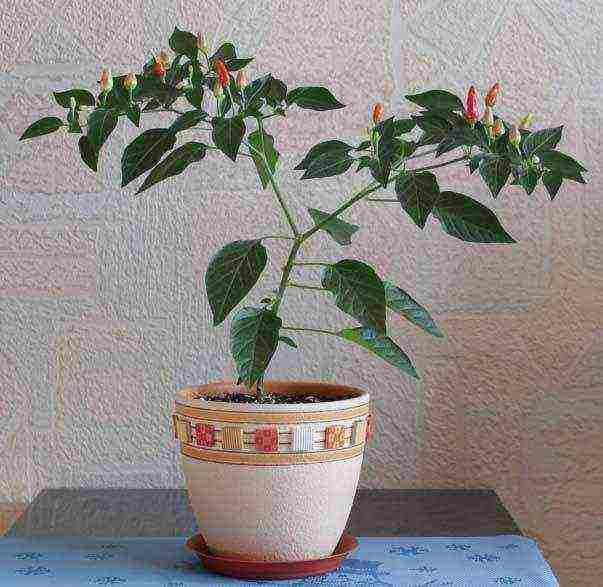
For the full growth of hot pepper on the windowsill, it is necessary carry out regular feeding. During the active growing season, preference should be given to mineral fertilizers with a high nitrogen content or organic fertilizers, and when forming buds and fruits, fertilizers with a large amount of potassium should be used. The plant should be fed once every 2 weeks.
Important! During the flowering period, it is recommended to shake the pot of pepper sometimes, which will improve the self-pollination of the flowers.
Major diseases and pests
Peppers, including indoor peppers, are susceptible to fungal diseases and various pests. Therefore, it is necessary to know in advance what problems may arise and how to deal with them.
- Aphid. This pest loves to feast on young shoots of pepper, therefore, it is on them that a large accumulation of pests is formed. To combat them, it is necessary to treat the plant with a phytoverm preparation.
- Spider mite. It is characterized by a stop of plant growth and curliness of young leaves, on which a small cobweb later appears. To combat the pest, it is necessary to spray with actellik, but after a week the procedure should be repeated.
- Whitefly. The accumulation of pests is observed on the back of the leaves, if you touch the shoots, then white flies fly over the plant. To eliminate the problem, it is recommended to carry out a complex treatment, which consists of spraying with actellik and irrigating with insecticide aktar, which is carried out on the same day. After 7 days, the procedure should be repeated.
- Decay of the stem at the base... It appears as a result of overflow of a plant, which leads to its death. It will no longer be possible to save the plant.
- Gray rot. Formation of wet spots with a gray bloom on any part of the plant. For treatment, it is recommended to use the biological product phytosporin.
- Blackleg. It affects the sprouts of pepper during the germination period. The stem at the base of the seedlings becomes thin and blackens. To prevent the disease, it is recommended to shed the soil and spray the shoots with the fungicide Previcur.
Video: how to care for and treat indoor peppers at home for diseases
Important! After the treatment with drugs, it is necessary to adhere to the waiting period indicated on the packaging of each product, it is not allowed to use pepper during this period for cooking.
The timing of the emergence of seedlings and the first harvest
Hot pepper seeds germinate for a long time, therefore this feature must be taken into account when planting. Seedlings appear within 14-21 days, subject to all planting recommendations.
The first crop of pepper on the windowsill ripens in 105-120 days from the moment the sprouts appear, depending on the variety chosen.
If you follow all the recommendations, growing hot peppers on the windowsill will not be difficult. But it must be understood that further care of the plant must meet all of its requirements, since the pepper will grow and bear fruit only taking into account all the necessary conditions.

Capsicum belongs to the Solanaceae family, its varieties are subdivided into hot and sweet. The bitter taste is given by the alkaloid capsaicin.
Decorative indoor peppers stand out effectively on the windowsill and serve as a source of spices for preparing a wide variety of dishes. In everyday life it is called "light", although in fact in culture there are several dozen species and varieties of plants. It is popular not only for its burning taste and attractive appearance, but also for its ease of growing at home.
- Selection of varieties and seeds for successful cultivation
- How to choose seeds for planting at home
- How to choose the best variety
- Seed germination technology
- Transplanting young plants to a permanent place
- Features of care and creation of conditions
- Stimulating flowering and fruiting
- What conditions are necessary for pepper
- Harvesting and Seeding Rules
- Caring for indoor peppers in a pot in winter
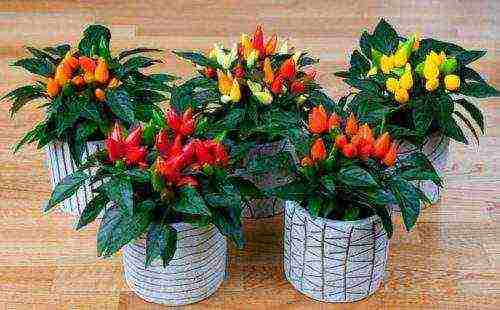
Selection of varieties and seeds for successful cultivation
The easiest way to propagate decorative indoor peppers is by seeds. The key to success in choosing the right planting material.
How to choose seeds for planting at home
Seeds taken from dried fruit are great. You can purchase planting material at gardening stores - or online stores that offer exotic and ornamental plant seeds. If you plant in February-March, you can easily get fruits already in September-October of the same year.

To begin with, you need to decide what kind of pepper you want to get in the end - high or low, spicy or not very, with fruit-berries or the classic "pepper" form. Typically, this information is on the packet. However, when purchasing, you need to pay attention to how long ago the seeds were collected?
Hot pepper seeds, if stored properly, can remain viable for up to 5 years, but every year the percentage of germinating falls... It is best to grow indoor peppers from seeds harvested last season if you plan to harvest this year.
The most important thing! Selected seeds should not have any flaws - dark specks, strong twisting, damage, traces of rot. Good quality seeds are pale yellow to almost white.
How to choose the best variety
Distinguish between early ripening, mid-ripening, late-ripening. You can enjoy the fruits of early-ripening varieties within 65-100 days from the moment of germination. Fruits from mid-season plants can be obtained in 100-120 days. But late-ripening varieties will be able to please you with a harvest only after 120-150 days.
Bush height... As a rule, lovers of indoor hot peppers prefer plentifully fruiting bushes up to 30 cm high - this is the optimal height of the bush for home-based peppers. There are also very miniature bushes 15 cm, and real giants up to a meter high.
Fruit shape... Most lovers prefer classic conical or elongated peppers. Fruits are round in shape, berries, are often mistaken for a close and poisonous relative - nightshade, and are considered inedible. This is not so - such a pepper can also be eaten, but if you are not sure that it is not nightshade, then it is better not to risk it. Fruits are also found in exotic forms, for example, Aji orchid.
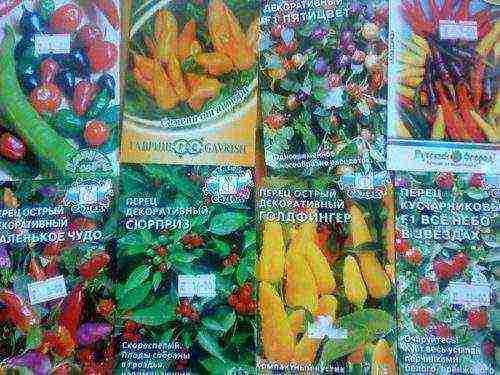
Fruit and leaf color... This is especially important if you plan to grow the plant as an ornamental plant. There are very decorative varieties of indoor peppers, for example, Bolivian rainbow, Fish, which, as they ripen, change their color several times, and at the final stage of ripening they can be yellow, orange or red.
The foliage of some varieties can also have blotches of different colors - white spots and dashes, lilac stripes, which become brighter, the more sunny the location of the plant.
Pungency - if you plan to eat the harvest of hot indoor peppers for food, it is important to make sure that you can do it - there are absolutely not spicy species, but there are ones that are so bitter that it is unsafe for an unprepared person to eat them. Especially appreciated among gourmets Habanero - the fruits, depending on the variety, differ in pungency, but they have an incomparable citrus-floral aroma and taste!
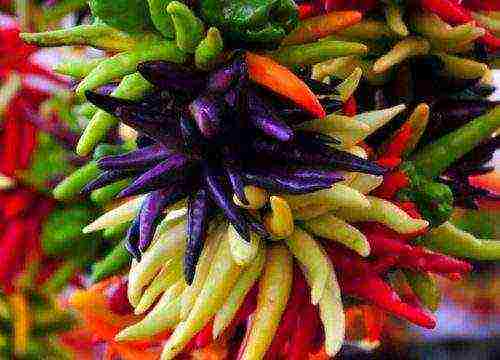
If you want to make hot peppers at home just for the sake of beauty, then the pungency is not important, but special attention should be paid to the decorative properties (height of the bush, shape and color, ripening features).
Seed germination technology
For planting five seeds of hot indoor pepper, a 300 ml plastic or ceramic flower pot is quite suitable. If you plan on planting in separate containers, you can choose smaller pots or use yogurt cups.
Step-by-step instructions for growing pepper from seeds at home:
- Pour drainage at the bottom of the container - expanded clay is best.
- Put the soil on top.Usually choose a ph-neutral soil for indoor plants or a mixture for peppers and tomatoes. Garden soil is not suitable, as it may contain insect larvae, fungal spores, which adversely affect seed germination.
- It is recommended to pre-soak the seeds in warm water for several hours for swelling and faster germination. Sometimes a stimulant is added to the soaking water, in particular - Epin, to increase germination. The use of a stimulant will not affect the plant in the future, but if the seeds are harvested 2-3 years ago, then the probability of successful germination will be higher. Can be planted without soaking.
- Distribute the planting material evenly over the soil surface at some distance from each other. This is necessary so that young plants do not interfere with each other as they grow.
- Sprinkle the seeds on top with soil - about 0.5 mm so that they are completely covered. If the surface of the soil is dry, moisten it with water, preferably from a sprinkler for flowers. It is important that the surface of the soil is slightly damp, but not wet, otherwise the seeds may rot.
- As the top layer of the soil dries up, it must be regularly moistened.
- It is advisable to put a plastic glass on top of the pot, thereby building a greenhouse. This is especially true if the planting takes place in February-March, and the indoor temperature may be below 25 degrees.
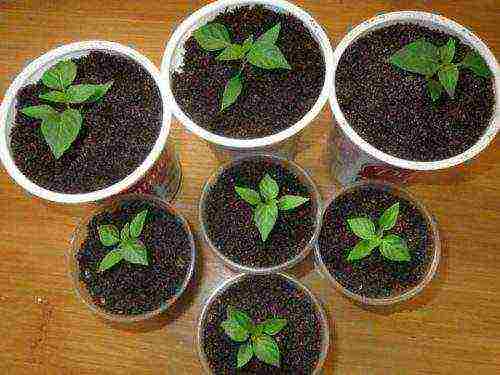
At a temperature of 22-25 degrees, shoots appear after 10-14 daysIf the seeds are harvested 2-3 years ago, the germination process may take another 1-2 weeks.
Seedlings must be periodically ventilated - raise the greenhouse for a short time so that young plants get used to the environment. Gradually, the "no greenhouse" periods should be increased and eventually removed altogether.
Transplanting young plants to a permanent place
When two pairs of true leaves appear on the seedlings, it is necessary to plant them if the seeds were planted in one container. If the seedlings were planted in individual pots, then you can transplant the plants into larger pots when the roots appear at the bottom of the water holes.
Leaving all plants in one pot is not worth it. Decorative bitter indoor peppers are grown according to the principle one pot - one plant... The fact is that, being planted together, the weaker specimens are “drowned out” by the stronger one. The weak will greatly lag behind in growth and development, flowering will be late and poor, and fruiting may not come at all.
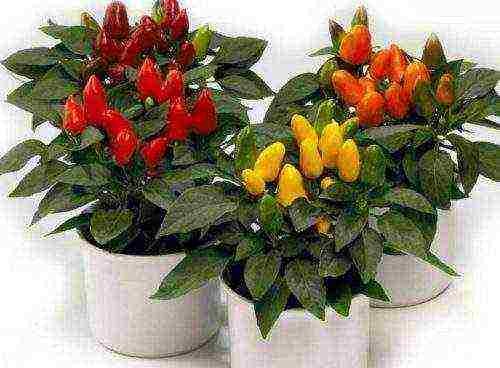
When seating, it is better to use small deep pots of 100 ml. Transplanting a young specimen immediately into a pot of very large volume is not useful - the "extra" earth will begin to sour from watering. It is better, as the plant grows, to gradually transfer it into a container, slightly larger than the previous one. The main sign that it is time to transplant the plant is the roots protruding from the bottom of the pot. During the season, as a rule, the bush is reloaded 2-3 times.
Features of care and creation of conditions
The goal of every home grower is to see their plant blooming, in the case of ornamental pepper, the finish is beautiful fruits that adorn the garden on the windowsill.
Stimulating flowering and fruiting
Young seedlings of "fire" on the windowsill begin to bloom about a month after the emergence of shoots. The first flowers will most likely be empty and fall off, but as they grow and develop, ovaries will appear and fruits will develop.

Special pollination is not required, but to increase the number of ovaries, you can periodically shake the pot with a bush or "pollinate" the flowers with a soft brush.
Depending on what kind of indoor hot pepper you have (early, mid or late), the first fruits can appear in summer, when the sun is most active, or in early to mid-autumn.
It is important to remember hot peppers at home does not require pinching and intensive formation of the bush in the first year of growth, cutting off flowers and the first ovaries. Indoor pepper "knows" to what height it needs to grow, when to start blooming and how many fruits to set. Your task is to provide him with comfortable growth conditions.
What conditions are necessary for pepper
Sunny location... It is advisable to keep the pot on the windowsill indoors. On very sunny balconies, the "lights" suffer greatly from the rays, the leaves can be damaged, the flowers fall off, and the fruits are strongly deformed and lack seeds.
In the shade, seedlings bloom reluctantly, set few fruits, and may suffer from the bay. Bushes of hot indoor decorative pepper feel extremely uncomfortable on the shelves, refrigerator and closet - away from the sun and fresh air.
Regular watering and spraying - the main components in the care of pepper at home. Ogonyok is very fond of water. In summer, on sunny days, the plant must be watered every day. Spray with water at room temperature, preferably twice a day.

Fertilizer... From March to September (and for late ripening ones - to October), it is advisable to feed indoor peppers with a specialized fertilizer for fruit plants. There is also a special fertilizer for peppers and tomatoes, which is found in shops for gardeners and florists.
Formation... In addition to the sun, water and a pot of sufficient volume, indoor hot peppers can be formed as the branches grow - this is important in late summer and autumn for plants of the first year of life and in early spring, when it comes out of dormancy.
They form, that is, cut too long branches - this gives a more neat look, allows the plant to save energy. But the main trunk should not be shortened - this may cause the bush to die.
Harvesting and Seeding Rules
As the fruit ripens, it is possible and necessary to harvest. There are varieties of indoor peppers, the pungency of which decreases at full maturity. Therefore, such fruits are harvested at the stage of technical ripeness. These unripe peppers are often much tastier than ripe ones.
For example, the fruits of the decorative bitter peppers of the Jalapeno variety (Jalapeno) are most often harvested when they are still green, but the characteristic "scars" have already appeared on them, but becoming red this species already loses its taste value.
If you are interested in seeds for planting in the future, then you need to wait until the fruits are fully ripe, that is, they acquire the final color (yellow, orange or red). The fruits must be removed from the bush and allowed to dry for several days.

If the pepper is thin-walled, then it dries quickly enough, if it is thick-walled, then when the fruit wrinkles, it must be carefully cut and allowed to dry again for several days.
Then the seeds are carefully removed and laid out on a napkin to dry. Well-dried seeds can be put in a bag and stored in a dry, dark place, storage in the refrigerator is allowed. The main thing is that moisture does not get in, in this case they can rot.
Caring for indoor peppers in a pot in winter
Contrary to popular belief, hot peppers are perennials. On average, the bush can bear fruit actively for 5 years. The main thing is to reload the plant as it grows and renew the soil every spring. However, not all growers are ready to provide the home handsome man with comfortable wintering conditions. Therefore, there are three possible options.
First... If you do not want to save this specimen, at the end of the season after the end of fruiting, the bush can be thrown away, and in February-March a new plant can be grown from the seeds obtained.
Second... If you are ready to save the plant, then at the end of the season you need to collect ripe fruits, reduce watering, avoiding prolonged drying out of the soil. Spray the bush with room temperature water every two to three days.

Gradually, the leaves will partially fall off.Sometimes the pepper sheds the leaves completely. Branches that are too long can be shortened slightly. In winter, new leaves and even flowers may appear on the branches, especially if the thaw lasts for a long time and the heating works intensively.
In February-March, indoor pepper will start growing again, at this moment it is necessary to transplant it into a pot slightly larger than the previous one, to replace the main part of the soil. Increase watering gradually.
Third... If you not only want to preserve the plant, but also to get a harvest in winter, then additional lighting is necessary. In this case, special lamps are installed, watering is not reduced, and fertilizing is continued.
As you can see, growing ornamental peppers at home does not require special knowledge and skills. A "light" in a pot is perfect for those who do not like to wait too long for the planted plant to finally bloom - only 3-4 months pass from seed to beautiful and fragrant fruits.
If you love indoor plants, learn how to grow an avocado from a seed, plumeria and adenium from seeds, and a violet from a leaf. Watching how a miracle is born is much more interesting than buying a ready-made flower in a store.
Hot peppers are added to confectionery, chocolate, coffee, tea - a very unusual and effective remedy in the fight against colds and flu!
Add this page to your favorites and share interesting information with your friends on social networks!


